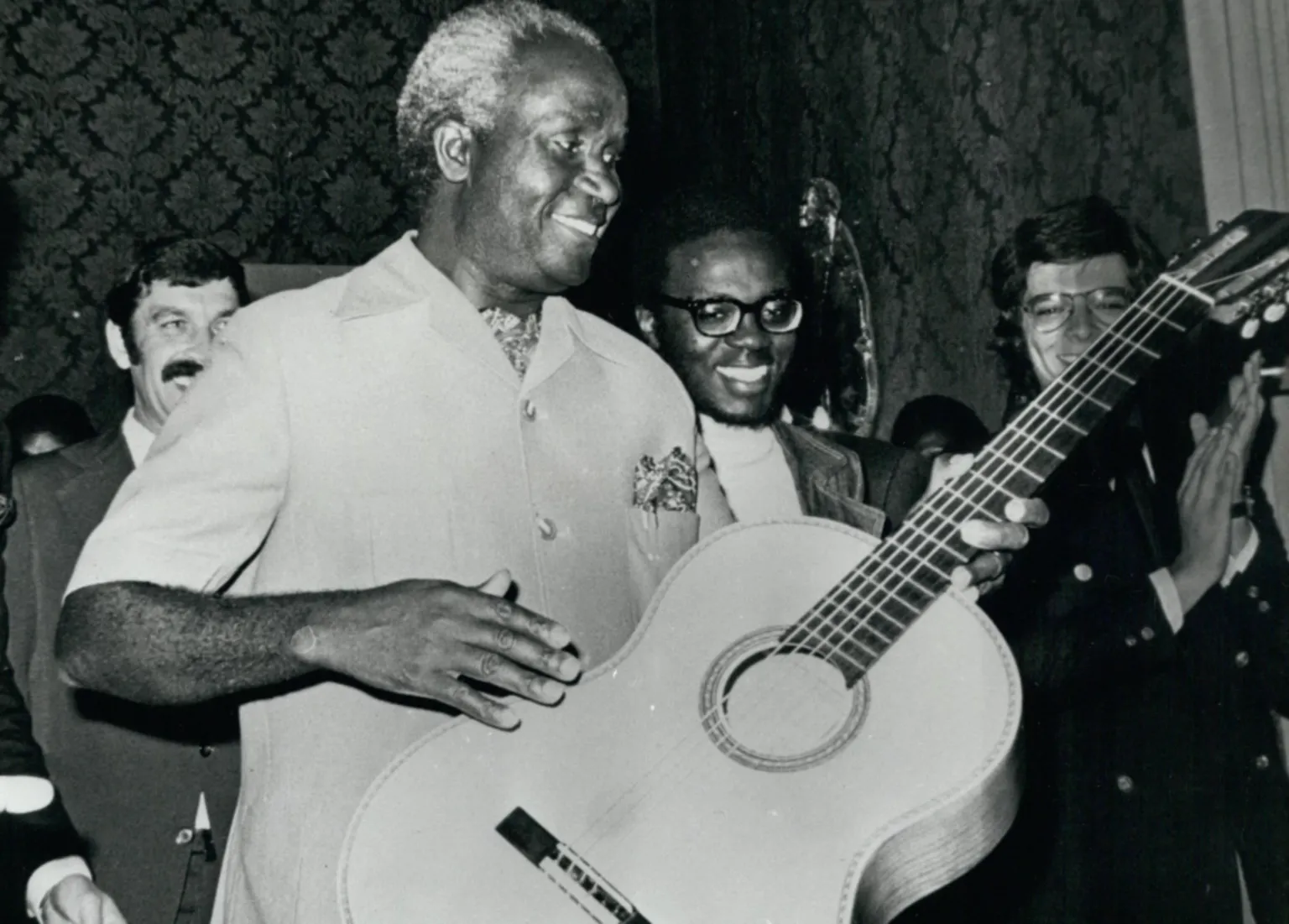How many African presidents do you know who are musicians?
Those from Uganda know that President Yoweri Museveni has sung more than 5 songs, the most famous being his debut song. Released in November 2010, You Want Another Rap? was his campaign song, and just as the song chorus goes, the Ugandans wanted another rap, and another rap they got, as Museveni won the elections, as well as the next two elections.
But before Museveni the rapper, we had Kenneth Kaunda the guitarist. Kenneth Kaunda loved playing the guitar and would carry it around with him, whether on local trips to visit chiefs, or on international trips to visit diplomats.

Figure 1: Kenneth Kaunda famously wields his guitar wherever he goes - here on an official visit to Portugal in 1975. Source: Alamy
This started during the struggle for independence, whereby Kaunda composed liberation songs, which he sang while travelling around the country to drum up support for the campaign against colonial rule.
In 1964, Zambia, or Northern Rhodesia, as it was known up to that point, finally gained independence from the British. However, one thing they did not gain independence from was British music, particularly Rock. British Rock seemed to have a chokehold on them. Artists and bands such as The Beatles, Rolling Stones and Jimi Hendrix were household names in Zambia. In fact, one was only considered a guitarist if they could perfectly play Hey Joe by Jimi Hendrix.
Therefore, most of the talented youth formed bands and created covers of songs by these artists.
One factor that influenced the spur of the Zambian cultural scene was the ready amount of disposable money. Following the departure of the British, the Zambians were left in charge of a very productive copper mining industry. The country’s workforce, quite young at the time, henceforth had money to spend on entertainment. And so, they would, in huge numbers, attend nightclubs to listen to music.
The young artists formed their bands and started performing in the nightclubs. This, they realized, was a better way to earn than doing blue-collar jobs. And true to word, it was.
President Kaunda, sensing the rising atmosphere of music around the country, decreed that radio stations must dedicate 95% of their air time to playing Zambian music. This was, seemingly, a massive boost to the local industry. And so, the bands that were previously performing British covers, saw this opportunity to directly earn from radio and decided to work on dropping their music.
At the time, there wasn’t a recording studio in Zambia, and thus the artists had to travel to Nairobi, Kenya. This was the only town in East Africa with a recording studio, meaning that artists from the region had to travel all the way to Nairobi, record their music, and then create as many vinyls as possible, then carry those that could fit in the boot of their car, to take them to their home country.
The first ever Zambian Rock, or Zamrock, album, was known as ‘Introduction’, and was sung by a band called WITCH (We Intend To Cause Havoc). Dropped in 1973, it was the first commercial album, and raked in huge sales, finally disposing the British Rock albums from the vinyl player. WITCH were very phenomenal for their time, and would even perform for seven hours on end, without resting. They would fill stadiums during their concerts, and even started doing tours in Zimbabwe, Botswana and Malawi.
After some time, Introduction by WITCH started being considered Western, for its heavy use of English, and so, to capitalize on this, another band called ‘Musi-O-Tunya’ dropped their own album, titled ‘Wings of Africa’. The latter album saw a mix of Western Rock instrumentalism with the Zambian native languages. This led to a lot of reverence as most of the people found solace in it and considered it their own.
After these two, the genre started seeing newer entrants, such as the Ngozi Family, Amanaz, Keith Mlevhu etc. However, just as the Zamrock scene was going up, so was the Zambian economy going down.
First, it started with the drop in the global copper prices. Contributing 95% of the country’s export earnings, such a decline meant that the country’s economy would tank. This meant that the workers now had less disposable income to spend on entertainment, so rock bands could no longer take gigs.
Neighbouring countries were also still fighting for independence, and so, more times than not, the battles would spill over into Zambia. To mitigate this, President Kaunda imposed a 6 am – 6 pm curfew to ensure that no one was found outside at the time of battle. This greatly affected the performing bands since most of their concerts would’ve been at night. This was also the time when disco clubs came up, ridding clubs of the need to have live performances. If WITCH thought they couldn’t perform simply because of curfews, then now they found out that they couldn’t perform at all, as no bar sought their services.
As if to hit the last hammer on the nail, the AIDS epidemic struck in the mid-80s, and due to their lifestyle, the disease washed out most of the Rock artists. Most, except for two. Emmanuel Jagari Chanda, who was the lead for WITCH, and Rikki Illionga, who was the lead for Musi-O-Tonyi.
Nearly 1.4 million Zambians died of the disease, and so, the Rock groups neither had the personnel to sing for, nor the audience to entertain. Thence, the genre of Zamrock died. If anything, I suggest a proper study should be conducted on the genre for proper scrutiny of the resources.
Special thanks to Keith Angana for contributing to the newsletter.
Join the Lughayangu Community!

